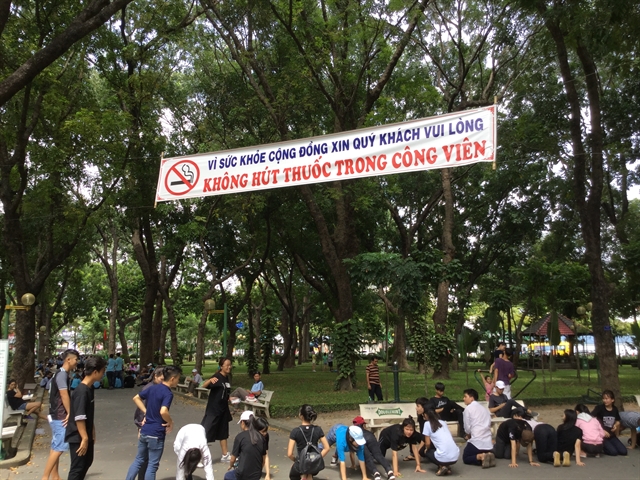
Many coffee shops in HCM City have ‘no smoking’ signs hanging everywhere, but people simply ignore them and light up.
HCM CITY Many coffee shops in HCM City have ‘no smoking’ signs hanging everywhere, but people simply ignore them and light up.
“We have to go and tell them to stop smoking to avoid the harmful influence [of the smoke] on us and our children,” Phan Thị Minh Hoa, a local, said.
Trần Thị Kim Xuân, also a city resident, said her husband was unable to give up smoking though she had talked about the harm it causes his health many times.
“Smokers do not see immediate harm to their health, so they are not scared,” she told a forum on how to improve enforcement of the Law on Prevention and Control of Tobacco Harms held yesterday by Đảng Cộng Sản Việt Nam (Communist Party of Vietnam) online newspaper and the Vietnam Non-communicable Diseases Prevention and Control Alliance.
Hoàng Thị Thu Hương of the Ministry of Health’s department of legal affairs said smoking remained commonplace at restaurants, hotels, hospitals, and other public places although the law bans smoking at many of these places.
“Smoking is a habit difficult to kick because it is addictive. The number of smokers in the country has decreased by less than 2 per cent after the Law on Prevention and Control of Tobacco Harms took effect in May 2013.”
Việt Nam ranks among the world’s top 15 tobacco consuming countries, according to the Global Adult Tobacco Survey.
Hương said though many programmes had been organised to disseminate information about the law by various agencies, the rate of people around the country knowing about the risks of smoking and the existence of the law was very low.
In HCM City, for instance, only 54 per cent know about them, according to its Department of Health.
Hương said the National Strategy on Tobacco Control aimed to increase the rate to 90 per cent by 2020.
Ngô Huy Toàn of the Ministry of Information and Communication said it was not easy to fine violators of the law and so smoking did not decrease.
“Five people die due to tobacco every hour, four times the number of deaths due to traffic accidents.”
Globally, 7.1 million deaths are related to tobacco every year, including 900,000 caused by secondhand smoke.
According to the American Cancer Society, smoke from the lighted end of a cigarette, pipe, cigar, or tobacco in a hookah has higher concentrations of cancer-causing agents (carcinogens) and is more toxic than mainstream smoke, or the smoke exhaled by a smoker.
It also has smaller particles than mainstream smoke which make their way into the lungs and the body’s cells more easily.
Secondhand smoke (SHS) is known to cause cancer. It has more than 7,000 chemicals, including at least 70 that can cause cancer.
SHS causes lung cancer even in people who have never smoked.
According to Dr Vũ Xuân Phú, deputy head of the National Lung Hospital, Việt Nam has 33 million secondhand smokers.
More than 45 per cent of people aged 15 and above smoke, and most of the 17 million smokers are men.
“Exposure to smoke can lead to 25-30 diseases.”
Tobacco prices are very low and “smoking is a trap to turn middle income people poor.”
Toàn said media communication about these harms should be stepped up to persuade people to give up smoking and build a smoke- free environment. VNS
OVietnam